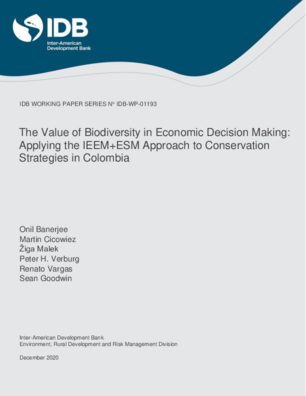The Value of Biodiversity in Economic Decision Making: Applying the IEEM ESM Approach to Conservation Strategies in Colombia
Date issued
Dec 2020
Subject
Natural Capital;
Biodiversity;
Land Use;
Ecosystem Service;
Reforestation;
IEEM Platform
JEL code
Q15 - Land Ownership and Tenure • Land Reform • Land Use • Irrigation • Agriculture and Environment;
C68 - Computable General Equilibrium Models;
E21 - Consumption • Saving • Wealth
Category
Working Papers
In this paper we evaluate the economic, natural capital and ecosystem services impacts of strategies for conserving Colombias rich natural capital endowment. Specifically, we consider Government program proposals for establishing Payment for Ecosystem Services (PES), implementing more sustainable silvopastoral systems and expanding habitat banking. We develop and apply the Integrated Economic-Environmental Modeling (IEEM) Platform linked with spatial Land Use Land Cover (LULC) and Ecosystem Services Modeling (IEEMESM) to shed light on the multi-dimensional impacts of these programs from the perspective of sustainable economic development and intergenerational wealth. Advancing the state-of-the-art in integrated economic-environmental modeling, our framework for the first time integrates dynamic endogenous feedbacks between natural capital, ecosystem services and the economic system to fully capture how changes in natural capital and ecosystem service flows affect the economy and vice versa. Our approach quantitatively models the economy, natural capital and ecosystem services as one integrated and complex system at a high level of spatial resolution across Colombias 32 Departments. We demonstrate how valuing biodiversity in public policy and investment analysis can make the difference between an investment that is economically viable and one that is not. Without accounting for the value of biodiversity, the proposed PES and habitat banking programs are not economically viable. Including the value of biodiversity, both PES and habitat banking become strong investment propositions with a net present value of US$4.4 billion and US$4.9 billion, respectively. The economic and environmental benefits of enhancing Colombias natural capital base and future ecosystem service supply are demonstrated and regionally differentiated, which provides a strong empirical evidence base to inform the spatial targeting of policies to maximize economic, environmental and social outcomes.
Generative AI enabled




